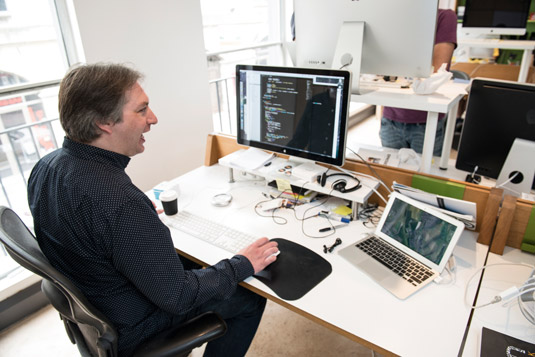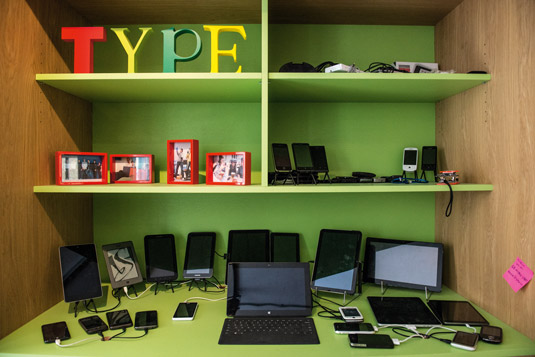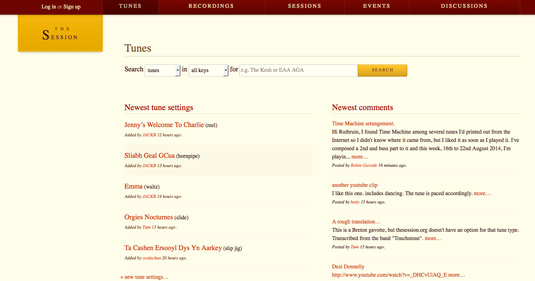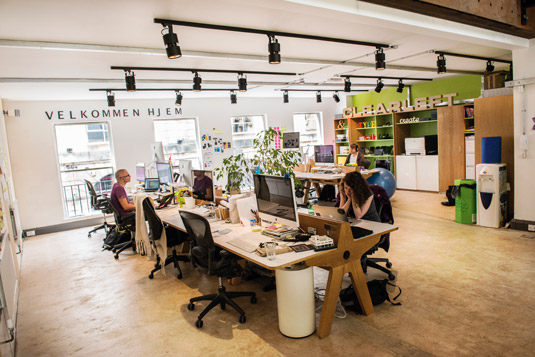Jeremy Keith on the importance of creating products that last
The self-styled 'sparkly code princess' chats about progressive enhancement, decentralisation and why he just can’t get excited about computers.
Life is good. The sky is blue, the sun is shining and, radiating an air of palpable relaxation, Jeremy Keith shows us to the balcony at the back of Clearleft's Brighton office. As seagulls circle, call and do something else that begins with 'c', Keith – looking occasionally skyward – sits back and begins the task of avoiding my questions.
"My job title, right now," he says, "is sparkly code princess, but I'm probably going to change that before the day is out. I was thinking, 'rear admiral of the responsive fleet'." Thankfully, Keith's Twitter profile gives a more prosaic summary of the man. It says he's an Irish web developer with Clearleft, and that he also runs the dConstruct conference in Brighton.
Clearleft – whose clients include Dennis Publishing's evo magazine, Kew Gardens and UNICEF – takes its name from a CSS property. The name, Keith tells us, is a geeky joke. He also likes the fact that it has a distinctly left-wing, socialist feel.
The beginnings
And his day job? How does his nine-to-five shape up? "I've no idea what my day job entails. I just don't know anymore. It used to be fairly straightforward. I was a frontend developer, a designer and a programmer. I used to freelance. Generally I was making websites. Now, I manage people who make websites... People who are much better and faster than me. I make sure they're happy."
Clearly in a playful mood, Keith isn't going to make my life easy. The secret of a good talk, he tells me, is sincerity. "Once you can fake that," he says, "you’ve got it made."
Thankfully he’s happier to answer questions about how he first found technology and the internet. "When I were a lad, my first computer had 1KB of RAM. The ZX81, named after the year it came out. I got a 16KB RAM pack round the back though."

Art not technology
He pauses for a minute before continuing. "I remember I really liked being able to program in BASIC, the classic thing. '10, print. 20, goto 10'. That feeling of making something with the computer, not making something physical – I was really into that."
That was very nearly the end of Keith's romance with technology. "I was more into design and art, art college and music," he says. "Years later I was reintroduced to the web and technology. I was late to it. It was the mid-'90s before I was discovering the web and browsers."
Indeed, he says, he finds it hard to get excited about gadgets, hardware and operating systems. "The fact," he says, "that the web involves computers is a by-product. It's the people and the stories and the things that you can do with technology that get me exited. It's hard to get excited about technology itself though.
The fact that the web involves computers is a by-product. It's things that you can do with technology that get me exited
"What fascinates me," he continues, "is the very basic idea of the web. This idea that anybody can publish on the web and other people can see it. People anywhere in the world. It's a very simple idea but all the permutations of that have influenced a lot of what I do."
Keith is a firm believer that people should share their work. "I've learned a lot from other people publishing so now I try to publish as much as I can," he explains. "The universality of access is something that's been absolutely key to everything I do, whether it's a personal project, my own site or client projects. What ever it is, I try not to destroy that central idea of the web."
Pausing, for a moment, he continues. "It's tricky though. Sometimes that idea of universality gets conflated with making things look the same to everyone. That's a very, very different idea."
This idea of universal access proves to be a recurring theme as we talk. Indeed, it underpins two of Keith's clarion calls: progressive enhancement and decentralisation of the web.
Facing the future
First, he explores progressive enhancement, explaining that if you build things the right way, they will last for years to come. "It's this idea of being future-friendly. You can't be future-proof, because you can't possibly predict what's going to come down the pipe in six, 12, 18 months.
"But you can be future-friendly by ensuring your stuff is built on a robust platform. That's where this whole idea of progressive enhancement comes in. It means you can build something that’s going to work on just about anything, old or new, and will continue to work on newer devices that you didn't predict... new interfaces... new input methods."
He says he likes this future-friendly idea because it pushes back against consumerism, and its culture of built-in obsolescence. "Look at mobile," he says. "People get a new device every 12 months. Think about the number of iPhones the average user has had since 2007. The idea that this stuff spends a few million years in the ground as oil, gets turned into a piece of plastic for 12 months and then spends another million years in landfill... it just doesn't scale. It can't continue.

"The idea that we can build our sites so that they work best on new devices but still work fine on old devices, to me, battles against that very consumerist, obsolescence-focused culture."
That’s all well and good, but how can we go about selling this idea of the perennial site to clients? "You don’t need to," Keith fires back. "A lot of this stuff – how you approach building a site – is your job. You need to involve the client in decisions around design direction and problem solving.
"The underlying approach, the engineering approach, isn't something you need to ask them about. I remember when we were switching from using tables for layout to CSS, back in the Standards days, and people were asking: 'How do I convince my client?’ I said don't. Just do it. Why should they care how you're building it as long as you're building something that meets their needs?"
Irish music online
So how does this all translate in practical terms? How can we hope to craft sites that actually stand the test of time? Unfazed, Keith begins to explain how he's done just that with his personal project, The Session – a site dedicated to sharing traditional Irish music.
"The site started in the late-'90s. I'm very into classic Irish music, and I knew I wanted to put something on the web to do with Irish music... So, I built this site. Early on, it became about user-generated content – people added tunes and content. I was proud of it. It was online for well over a decade and it was a great community site."
Keith, however, was frustrated with the site. He continues: "There were so many new technologies I could take advantage of. So a couple of years ago I did a big overhaul of the visual design and also the underlying technologies. It was an interesting opportunity to look and see what had been working over 10 years. What would I keep? And, what would I use today... evaluating new technologies that I think will still work in 10 years. I had a good long-term lens."

Continuing, he explains: "There were various CSS technologies I might use. There are bits of markup we have now that we didn't have before. More important was the approach – this idea of progressive enhance- ment. This idea that you have a really robust and solid foundation is, essentially, HTML that uses links and forms to achieve your goals.
And then adding in the new stuff... fancy animations, enhancements, geoloca-tion, all these new APIs. That approach that worked 10 years ago, still works today and I think it will work in 10 years, even though the technology is constantly changing."
Don't forget HTML
"It's funny," Keith remarks. "HTML gets dismissed as being the least important [component]. It's just an implementation detail for people building complex things. It's like it's just a small detail. People tend to focus on the JavaScript because that's where the logic lies. But, if you flip that on its head, HTML is the thing people are actually going to interact with... the DOM in the browser."
HTML is the thing people are actually going to interact with... the DOM in the browser
Keith's advice is to make sure the HTML is as robust as possible, and ensure it works by itself and doesn't rely on the CSS or JavaScript to function. "And again, looking at the long-term technologies, HTML has been around this long," he adds. "It's changed and it's evolved, but I think it's the one that will be around for a good while yet. CSS might go away. That's okay. It's subservient to the HTML. And JavaScript. It might be eating the world right now and becoming the most popular language. HTML, URLs and HTTP: that's what the web is for me."
A space of your own
Turning now to decentralisation, Keith says: "That fundamental idea of the web – 'share what you know' – that's enormously powerful. The early web is full of that. You had a website. You had your place on the web and anybody could access that. But, that's changed over time as these large monolithic platforms have come about.
Over time, these large platforms have come about. You're pitching your tent in somebody else's back garden
Okay, you can have a website but it has to be on Facebook or Tumblr. They make it very easy to publish but the price you pay is you're pitching your tent in somebody else's back garden. You have to abide by their rules and if they change the rules you don't get a say in that."
He talks through the worst-case scenario – the platform is bought out or shut down, and those working from it are faced with exporting all their data within 30 days, and losing all their URLs. It's not a pleasant thought. "I hate that idea of being beholden to a landlord in that way, I much prefer to have my own place on the web," he concludes.

So, in the face of all this, how does Keith stay true to his values? "What I tend to do is have the canonical copy on my website and syndicate out to other places. So, I post notes on my website and they get copied to Twitter as tweets. Or, I'll post a blog on my site and it'll get pushed to Facebook. So, I get the benefits of the big silos.
"But, if it's something you care about you should own it, right? Sure, owning your website is too geeky for most people, which is a shame. But, I'd like to see the power you get with Facebook and Tumblr, combined with the power of owning your own site."
Words: Martin Cooper
Martin Cooper is deputy editor of net magazine. This article originally appeared in net magazine issue 257.

Thank you for reading 5 articles this month* Join now for unlimited access
Enjoy your first month for just £1 / $1 / €1
*Read 5 free articles per month without a subscription

Join now for unlimited access
Try first month for just £1 / $1 / €1
Get the Creative Bloq Newsletter
Daily design news, reviews, how-tos and more, as picked by the editors.

The Creative Bloq team is made up of a group of art and design enthusiasts, and has changed and evolved since Creative Bloq began back in 2012. The current website team consists of eight full-time members of staff: Editor Georgia Coggan, Deputy Editor Rosie Hilder, Ecommerce Editor Beren Neale, Senior News Editor Daniel Piper, Editor, Digital Art and 3D Ian Dean, Tech Reviews Editor Erlingur Einarsson, Ecommerce Writer Beth Nicholls and Staff Writer Natalie Fear, as well as a roster of freelancers from around the world. The ImagineFX magazine team also pitch in, ensuring that content from leading digital art publication ImagineFX is represented on Creative Bloq.
